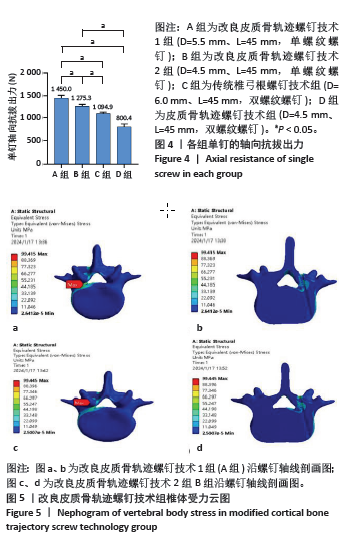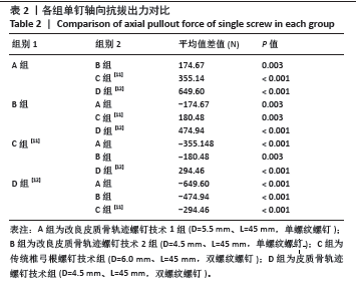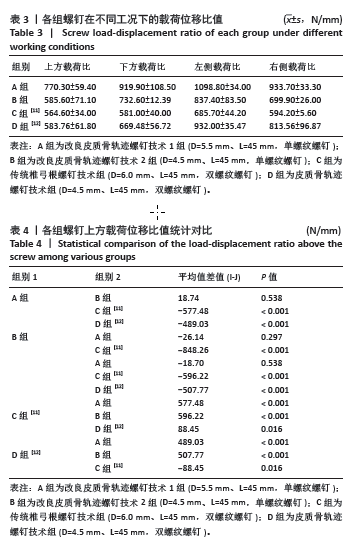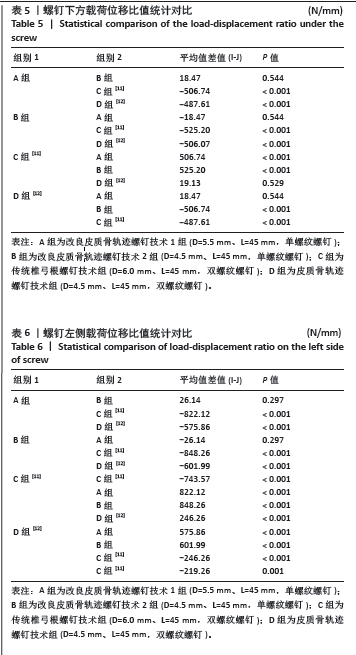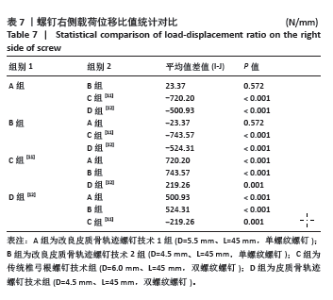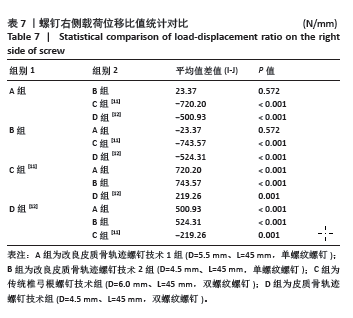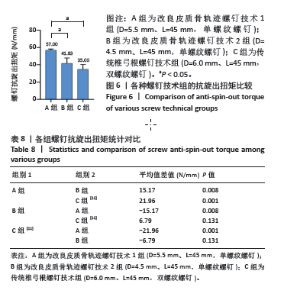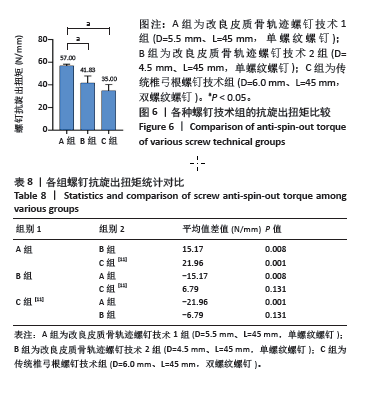[1] SANTONI BG, HYNES RA, MCGILVRAY KC, et al. Cortical bone trajectory for lumbar pedicle screws. Spine J. 2009;9(5):366-373.
[2] UENO M, SAKAI R, TANNKA K, et al. Should we use cortical bone screws for cortical bone trajectory? Neurosurg Spine. 2015;22(4):1-6.
[3] LONSTEIN JE, DENIS F, PERRA JH, et al. Complications associated with pedicle screws. J Bone Joint Surg Am. 1999;81(11):1519-1528.
[4] AKPOLAT YT, İNCEOĞLU S, KINNE N, et al. Fatigue Performance of Cortical Bone Trajectory Screw Compared With Standard Trajectory Pedicle Screw. Spine (Phila Pa 1976). 2016;41(6):E335-E341.
[5] IWATSUKI K, YOSHIMINE T, OHNISHI Y, et al. Isthmus-guided cortical bone trajectory for pedicle screw insertion. Orthop Surg. 2014; 6: 244-248.
[6] REXITI P, AIERKEN G, WANG S, et al. Anatomical research on strength of screw track fixation in novel cortical bone trajectory for osteoporosis lumbar spine. Am J Transl Res. 2019;11(11) : 6850-6859.
[7] 周志豪,王轶希,刘东山,等.传统椎弓根螺钉与改良皮质骨轨迹置钉技术的生物力学性能有限元分析[J].中国组织工程研究, 2022,26(18):2789-2794.
[8] REXITI P, AIERKEN A, SADEER A, et al. Anatomy and imaging studies on cortical bone screw freehand placement applying anatomical targeting technology. Orthop Surg. 2020;12(6):1954-1962.
[9] KOTANI Y, KOIKE Y, IKEURA A, et al. Clinical and radiologic comparison of anterior-posterior single-position lateral surgery versus MIS-TLIF for degenerative lumbar spondylolisthesis. J Orthop Sci. 2021;26(6): 992-998.
[10] WELCH-PHILLIPS A, GIBBONS D, AHERN DP, et al. What Is Finite Element Analysis? Clin Spine Surg. 2020;33(8):323-324.
[11] 张治豪,居来提·买提肉孜,张连鹏,等.新型变径全皮质骨螺纹螺钉设计以及在腰椎改良皮质骨轨迹的应用[J].医用生物力学, 2024,39(1):91-97.
[12] 张连鹏, 居来提·买提肉孜, 张治豪,等.皮质骨轨迹置钉在腰椎翻修中的力学分析[J].中国组织工程研究,2024,28(24):3783-3788.
[13] WU XY, WANG Z, GAN HR, et al. The cortical bone trajectory screw techniquewas applied to nite element analysis of lumbar xation in patients with osteoporosis. Chin J Orthop Surg. 2018;26(12): 1126-1131.
[14] ROY-CAMILLE R, SAILLANT G, MAZEL C. Internal fixation of the lum-bar spine with pedicle screw plating. Clin Orthop Relat Res. 1986;(203):7-17.
[15] Chinese Society of Osteoporosis And Bone Mineral Research. China Osteoporosis Epidemiological Survey and “Healthy Bones” Special Action Results Released. Chin J Osteoporosis Bone Miner Res. 2019; 12(4):317-318.
[16] SHEVROJA E, CAFARELLI FP, GUGLIELMI G, et al. DXA parameters, Trabecular Bone Score (TBS) and Bone Mineral Density (BMD), in fracture risk prediction in endocrine-mediated secondary osteoporosis. Endocrine. 2021;74(1):20-28.
[17] COMPSTON JE, MCCLUNG MR, LESLIE WD. Osteoporosis. Lancet. 2019;393(10169):364-376.
[18] MATSUKAWA K, YATO Y. Lumbar pedicle screw fixation with cortical bone trajectory: A review from anatomical and biomechanical standpoints. Spine Surg Relat Res. 2017;1(4):164-173.
[19] WANG Y, KAHAER A, MAIMAITI A, et al. Complication, fusion, and revision rate in the lumbar cortical bone trajectory and pedicle screw fixation techniques: a systematic review and meta-analysis. J Orthop Surg Res. 2023;18(1):382.
[20] REXITI P, AIKEREMU D, WANG S, et al. Cadaveric study of anatomical measurement of isthmus parameters of lumbar spine to guide cortical bone screw placement. Rev Assoc Med Bras (1992). 2022;68(6): 754-758.
[21] REXITI P, ABULIZI Y, MUHEREMU A, et al. Anatomical and radiologic characteristics of isthmus parameters in guiding pedicle screw placement. J Int Med Res. 2018;46(6):2386-2397.
[22] REXITI P, AIERKEN G, WANG S, et al. Anatomical research on strength of screw track fixation in novel cortical bone trajectory for osteoporosis lumbar spine. Am J Transl Res. 2019;11(11):6850-6859.
[23] FUJIWARA S, OHNISHI Y, IWATSUKI K, et al . Cortical bone trajectory fixation cause low compression force in anterior vertebral column. N Am Spine Soc J. 2022;10:100113.
[24] KAHAER A, MAIMAITI X, MAITIROUZI J, et al. Biomechanical investigation of the hybrid modified cortical bone screw-pedicle screw fixation technique: Finite-element analysis. Front Surg. 2022;9:911742.
[25] 王轶希,居来提·买提肉孜,王水泉,等.有限元分析腰椎传统椎弓根钉道和改良皮质骨钉道的生物力学性能[J]. 医用生物力学, 2022,37(3):485-491.
[26] SALUNKE P, KARTHIGEYAN M, UNIYAL P, et al. A Novel Pedicle Screw Design with Variable Thread Geometry: Biomechanical Cadaveric Study with Finite Element Analysis. World Neurosurg. 2023;172:e144-e150.
[27] JAZINI E, PETRAGLIA C, MOLDAVSKY M, et al. Finding the right fit: studying the biomechanics of under-tapping with varying thread depths and pitches. Spine J. 2017;17(4):574-578.
[28] WEISER L, SELLENSCHLOH K, PÜSCHEL K, et al. Cortical threaded pedicle screw improves fatigue strength in decreased bone quality. Eur Spine J. 2021;30(1):128-135.
[29] LIU D, KAHAER A, WANG Y, et al. Comparison of CT values in traditional trajectory, traditional cortical bone trajectory, and modified cortical bone trajectory. BMC Surg. 2022;22(1):441.
[30] EDWARDS WT, ZHENG Y, FERRARA LA, et al. Structural features and thickness of the vertebral cortex in the thoracolumbar spine. Spine (Phila Pa 1976). 2001;26(2):218-225.
[31] MCLACHLIN SD, BEATON BJB, SABO MT, et al. Comparing the fixation of a novel hollow screw versus a conventional solid screw in human sacra under cyclic loading. Spine (Phila Pa 1976). 2008;33(17):1870-1875.
[32] BIANCO RJ, ARNOUX PJ, WAGNAC E, et al. Minimizing Pedicle Screw Pullout Risks: A Detailed Biomechanical Analysis of Screw Design and Placement. Clin Spine Surg. 2017;30(3):E226-E232.
[33] MATSUKAWA K, YATO Y, IMABAYASHI H. Impact of Screw Diameter and Length on Pedicle Screw Fixation Strength in Osteoporotic Vertebrae: A Finite Element Analysis. Asian Spine J. 2021;15(5):566-574.
[34] 周绍波,冯文强,江文涛,等.内固定术中螺钉稳定性影响因素的研究现状[J].中华创伤骨科杂志,2018,20(6):548-552.
[35] VARGHESE V, KRISHNAN V, SARAVANA KUMAR G. Testing Pullout Strength of Pedicle Screw Using Synthetic Bone Models: Is a Bilayer Foam Model a Better Representation of Vertebra? Asian Spine J. 2018;12(3):398-406.
[36] ÇETIN A, BIRCAN DA. Experimental investigation of pull-out performance of pedicle screws at different polyurethane (PU) foam densities. Proc Inst Mech Eng H. 2021;235(6):709-716.
[37] TSAI WC, CHEN PQ, LU TW, et al. Comparison and prediction of pullout strength of conical and cylindrical pedicle screws within synthetic bone. BMC Musculoskelet Disord. 2009;10:44.
[38] SENG WRD, CHOU SM, SIDDIQUI SS, et al. Pedicle Screw Designs in Spinal Surgery. Spine (Phila Pa 1976). 2019;44(3):E144-E149.
[39] MATSUKAWA K, YATO Y, KATO T, et al. In vivo analysis of insertional torque during pedicle screwing using cortical bone trajectory technique. Spine(PhilaPa1976). 2014;39(4):E240-E245.
[40] KAHAER A, ZHANG R, WANG Y, et al. Hybrid pedicle screw and modified cortical bone trajectory technique in transforaminal lumbar interbody fusion at L4-L5 segment: finite element analysis. BMC Musculoskelet Disord. 2023;24(1):288. |

